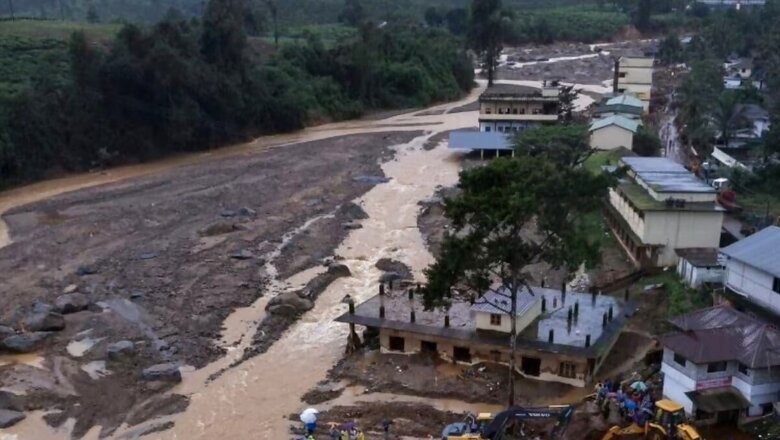
views
Human-induced climate change has made short bursts of extreme rainfall events almost 10 per cent more intense in Wayanad, said a team of international scientists who analysed the devastating landslide that impacted Kerala, claiming over 231 lives while many others were reported missing.
The multiple landslides triggered by heavy rains on the intervening night of July 29-30 wiped out two villages — Mundakkai and Chooralmala — and dislodged an entire hillside. Led by 24 researchers from the US, UK, Malaysia, Sweden including six scientists from India, the World Weather Attribution (WWA) group dived in to investigate the role of global warming in one of the deadliest landslides in Kerala’s history.
About 140mm rain fell on July 30 — the third-heaviest daily rainfall recorded in Kerala after 2019 and 1924. “Such one-day spells of heavy rains are increasing in Kerala. In today’s climate with 1.3°C of global warming, they are more likely and expected to occur on average about once every 50 years,” said Mariam Zachariah, researcher at the Grantham Institute — Climate Change and Environment, Imperial College London.
According to the rapid analysis, the landslides were triggered by a burst of rainfall that was made about 10 per cent heavier by human-caused climate change. Under a future warming scenario where the global temperature is 2°C higher than pre-industrial levels, the climate models predict a further increase of about 4 per cent in rainfall intensity. This is also because for every 1℃ rise in global temperature, the moisture-holding capacity of the atmosphere increases by 7 per cent, which is making extreme rains more intense, and frequent across countries.
In order to quantify the impact of global warming on the heavy rains in Kerala, the team analysed weather data and high-resolution climate models, and used peer-reviewed methods to compared how such events have changed from pre-industrial climate and current climate with nearly 1.2℃ warming, focusing only on 24-hour rainfall events from June to September in Northern Kerala.
“The findings reported here are physically consistent with those predicted by climate science. These direct threats to people in India will continue to escalate as the climate warms and humans continue to regulate natural systems,” said Associate Professor Arpita Mondal from the Indian Institute of Technology, Bombay (IIT-B).
62% REDUCTION IN FOREST COVER
While the linkage between land cover and land use changes and landslide risk in Wayanad is mixed in the current study, the scientists highlighted that factors such as quarrying for building materials and a 62 per cent reduction in forest cover may have made the slopes much more susceptible when the heavy rain fell.
Previous studies show that between 1950 and 2018, Wayanad lost 62 per cent of its green cover, with tea plantation areas increasing by approximately 1,800 per cent, resulting in reduced forest cover to stabilise the hills. These changes had significantly altered the face of the district already in 2012, after which plantations continued to expand from 913 to 1215 km2 while forests shrunk from 888 to 672 km2, the study noted. In addition, quarrying activities led to increased slope instability, especially during the monsoon, and studies show their continuation despite efforts to reduce illegal quarrying.
BRACE FOR MORE EXTREME WEATHER EVENTS
The latest projections show that the increase in climate change-driven rainfall is likely to increase the number of landslides that could be triggered in the future.
“The devastation in Northern Kerala is concerning because this disaster occurred in a continually warming world. While it is important to move away from fossil fuels, the world also needs to adapt to extreme weather. Reinforcement of susceptible slopes, construction of retaining structures to protect vulnerable localities and planting suitable vegetation on slopes and protecting forest reserves are some measures that can help minimise the landslide risk in future,” said Maja Vahlberg, climate risk consultant at Red Cross Red Crescent Climate Centre.



















Comments
0 comment